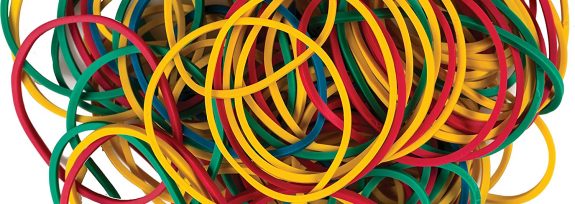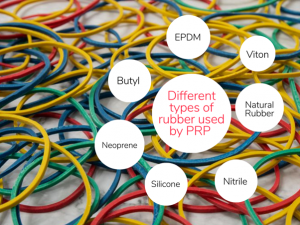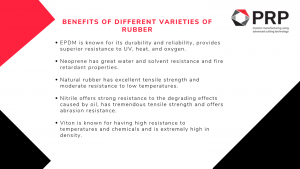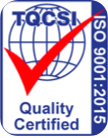What are PRP’s rubber cutting capabilities?
PRP uses a variety of different rubber compounds to produce a wide range of custom products. Below you can find out more about our precision rubber cutting expertise.

Rubber is a versatile material that is used over a wide range of industries, from agriculture to mining to defence and many others. Some of our rubber-based products made using precision rubber cutting techniques include seals and gaskets. These can range from pipe and flanges designed to international standards, to custom-designed profiles specific to the needs of a certain standard or project.
There are different compounds of rubber that have distinct properties to one another. This makes them either suitable or unsuitable depending on the use case. Some of the common compounds of rubber include Ethylene Propylene (EPDM), Neoprene (Chloroprene), Natural rubber, and Nitrile. Moreover, PRP also specialises in niche rubber compounds such as Viton, Silicone and Butyl.

What is EPDM rubber and what advantages or disadvantages does it have?
EPDM is widely used across a range of industries mainly because of its age resistance properties and resistance to UV, heat, oxygen, acid and alkali. This, over general grades of rubber, enhances the durability and longevity of the products it is used in.
EPDM’s use cases include a wide range of gasket seal manufacturing that can be customised according to our customers technical requirements and specifications. It also has good water reticulation properties which is why EPDM is used to produce rubber products suitable for potable water and agriculture-related uses.
Moreover, EPDM rubber has use cases in the food processing industry (and can comply to FDA approval).
However, EPDM is usually not suggested for products that are used with oil and hydrocarbon solvents. EPDM is also slightly more expensive than some of our other general compounds.
Is Neoprene different to EPDM and what is it used for?
Neoprene, or Chloroprene, is another highly used rubber compound that is suitable for products across a range of industries. One of the main differences between Neoprene and EPDM is Neoprene provides moderately better oil resistance when compared to EPDM. It further has solvent resistance properties and can be made as a fire-retardant material, making it unique and possibly attractive in industries such an electrical or defence.
Some of Neoprene’s other properties include varieties of densities (softness), tensile strength (wearability) and ability to elastically deform (flexibility), making it an attractive prospect for the packaging and medical industry.
Furthermore, due to its oil resistance properties, it can also used to manufacture seals used in the automotive sector, although Nitrile rubber is generally preferred in this area.
Neoprene has limitations which include poor resistance to low temperatures and limited resistance to sunlight.

What makes Natural rubber unique compared to other types of rubber?
Natural rubber can provide great value for customers because it can be considerably cheaper than other varieties of rubber. It is used diversely among many applications and some of its strongest properties include its excellent tensile strength and moderate resistance to low temperatures.
Some of its use cases include seals and gaskets required in the water and agricultural industry. It is also used in different pipe and flange systems, for example British Table D and E, and ASME/ANSI related international standards.
However, it has certain limitations when compared to synthetic rubber, such as very limited high temperature resistance, poor resistance to hydrocarbon solvents, oil, and environmental particulates.
What makes Nitrile one of the strongest compound of rubber used for various products?
Although Nitrile rubber is usually more expensive than Neoprene, EPDM and natural rubber, it generally is justified because of its excellent engineering characteristics. Nitrile offers strong resistance to the degrading effects caused by oil, has tremendous tensile strength, and offers abrasion resistance.
Due to its unique properties, Nitrile is used in laser cutting and shaping rubber products for a wide range of industries such as defence, automotive and mining. It is also used for the production of gaskets and seals by using precision rubber cutting techniques. PRP has produced and services many large scale defence-related projects utilising Nitrile’s characteristics.
The others
Although EPDM, Neoprene, Natural and Nitrile are the four most widely used rubber types, PRP also stocks other niche compounds, such as Viton, Silicon and Butyl. Viton is one of the most expensive types of rubber, known for having high resistance to temperatures and a wide variety of chemicals. Viton is also extremely high in density. Silicon on the other hand can mostly withstand temperatures up to 250° Celsius and has specific chemical resistance properties. Lastly, Butyl is known for its impermeability to gases and air and its ability to absorb extremely high levels of energy. This makes Butyl an excellent material historically used for many components within the automotive industry.
Summary
Different rubber compounds such as Neoprene, EPDM, Natural, Nitrile, Viton, Silicon and Butyl all exhibit different properties and thus use cases. PRP with its expertise and capabilities has consistently delivered high-quality rubber-based products catering to the needs of a diverse range of industries.
Our extensive knowledge guided by three decades of experience has allowed us to become experts in not just the rubber cutting field, but also CNC cutting and shaping of other materials such as sponge, foam, acrylic, plastic and insulation.
Please contact us if you wish to discuss your requirements!
